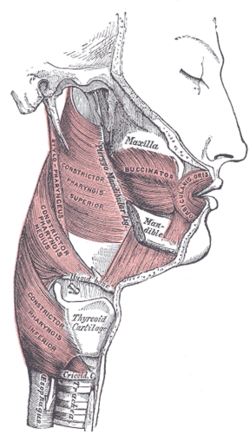Parapharyngeal space
| Parapharyngeal space | |
|---|---|
 Lateral head anatomy detail | |
 Muscles of the pharynx and cheek. | |
| Details | |
| Identifiers | |
| Latin | Spatium lateropharyngeum, spatium pharyngeum laterale, spatium parapharyngeum |
| MeSH | D000080886 |
| TA98 | A05.3.01.117 |
| TA2 | 2883 |
| FMA | 84967 |
| Anatomical terminology | |
The parapharyngeal space (also termed the lateral pharyngeal space), is a
Anatomical boundaries
The parapharyngeal space is shaped like an inverted pyramid. Lateral and inferior to the parapharyngeal space is the
The medial aspect is made up of the
Divisions
The parapharyngeal space is divided into 2 parts by the fascial condensation called the aponeurosis of Zuckerkandl and Testut (stylopharyngeal fascia - see diagram), which can be a source of confusion.
Contents
It includes the maxillary artery and ascending pharyngeal artery.[6]
- Glossopharyngeal nerve (IX)
- Vagus nerve (X) together with
- Internal carotid artery
- Internal jugular vein in the carotid sheath
- Accessory nerve (XI)
- Hypoglossal (XII)
- Sympathetic trunk and superior cervical ganglion of the trunk
- Ascending pharyngeal artery
- Deep cervical lymph nodes
Clinical significance
First bite syndrome is a rare complication of a surgery involving the parapharyngeal space, especially removal of the deep lobe of the parotid gland. It is characterized by facial pain after the first bite of each meal, and is thought to be caused by autonomic dysfunction of salivary myoepithelial cells.
References
- ^ PMID 6863661.
- PMID 3830193.
- ^ Hermans 2006, p. 165
- ^ Fakhry 2016.
- ^ Jeremy Jones. "Carotid space". radiopaedia.org.
- ^ "EURORAD - Radiologic Teaching Files". eurorad.org.
Bibliography
- Hermans, Robert (2006). Head and Neck Cancer Imaging. Springer Science & Business Media. ISBN 978-3-540-22027-5.
- Fakhry, Nicolas (25 July 2016). "A proposal for a level for parapharyngeal extension of parotid gland". European Archives of Oto-Rhino-Laryngology. 273 (10): 3455. PMID 27455864.
